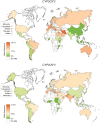Global distribution of functionally important CYP2C9 alleles and their inferred metabolic consequences
- PMID: 36855170
- PMCID: PMC9976394
- DOI: 10.1186/s40246-023-00461-z
Global distribution of functionally important CYP2C9 alleles and their inferred metabolic consequences
Abstract
Background: Genetic variability in the cytochrome P450 CYP2C9 constitutes an important predictor for efficacy and safety of various commonly prescribed drugs, including coumarin anticoagulants, phenytoin and multiple non-steroidal anti-inflammatory drugs (NSAIDs). A global map of CYP2C9 variability and its inferred functional consequences has been lacking.
Results: Frequencies of eight functionally relevant CYP2C9 alleles (*2, *3, *5, *6, *8, *11, *13 and *14) were analyzed. In total, 108 original articles were identified that included genotype data from a total of 81,662 unrelated individuals across 70 countries and 40 unique ethnic groups. The results revealed that CYP2C9*2 was most abundant in Europe and the Middle East, whereas CYP2C9*3 was the main reason for reduced CYP2C9 activity across South Asia. Our data show extensive variation within superpopulations with up to tenfold differences between geographically adjacent populations in Malaysia, Thailand and Vietnam. Translation of genetic CYP2C9 variability into functional consequences indicates that up to 40% of patients in Southern Europe and the Middle East might benefit from warfarin and phenytoin dose reductions, while 3% of patients in Southern Europe and Israel are recommended to reduce starting doses of NSAIDs.
Conclusions: This study provides a comprehensive map of the genetic and functional variability of CYP2C9 with high ethnogeographic resolution. The presented data can serve as a useful resource for CYP2C9 allele and phenotype frequencies and might guide the optimization of genotyping strategies, particularly for indigenous and founder populations with distinct genetic profiles.
Keywords: Allele frequency; Metabolizer phenotype; Pharmacogenomics; Precision medicine; Precision public health.
© 2023. The Author(s).
Conflict of interest statement
YZ and VML are co-founders and shareholders of PersoMedix AB. In addition, VML is CEO and shareholder of HepaPredict AB. EE is vice-chair of the Genomic Medicine Sweden Pharmacogenomics work package, supported by grants from The Swedish Innovation Agency. EE also received funding from the Stockholm Region (CIMED). The other authors do not disclose competing interests.
Figures


Similar articles
-
The Impact of CYP2C9*11 Allelic Variant on the Pharmacokinetics of Phenytoin and (S)-Warfarin.Clin Pharmacol Ther. 2022 Jul;112(1):156-163. doi: 10.1002/cpt.2613. Epub 2022 May 5. Clin Pharmacol Ther. 2022. PMID: 35426132 Free PMC article.
-
Meta-analysis of the global distribution of clinically relevant CYP2C8 alleles and their inferred functional consequences.Hum Genomics. 2024 Apr 22;18(1):40. doi: 10.1186/s40246-024-00610-y. Hum Genomics. 2024. PMID: 38650020 Free PMC article.
-
Phenytoin Metabolic Ratio, a Marker of CYP2C9 Activity, is Superior to the CYP2C9 Genotype as a Predictor of (S)-Warfarin Clearance.Clin Pharmacokinet. 2022 Aug;61(8):1187-1198. doi: 10.1007/s40262-022-01141-2. Epub 2022 Jun 14. Clin Pharmacokinet. 2022. PMID: 35699912
-
VKORC1 and CYP2C9 genotype distribution in Asian countries.Thromb Res. 2014 Sep;134(3):537-44. doi: 10.1016/j.thromres.2014.05.028. Epub 2014 May 27. Thromb Res. 2014. PMID: 24908449 Review.
-
Worldwide interethnic variability and geographical distribution of CYP2C9 genotypes and phenotypes.Expert Opin Drug Metab Toxicol. 2015;11(12):1893-905. doi: 10.1517/17425255.2015.1111871. Epub 2015 Nov 23. Expert Opin Drug Metab Toxicol. 2015. PMID: 26595139 Review.
Cited by
-
Continuous co-prescription of rebamipide prevents upper gastrointestinal bleeding in NSAID use for orthopaedic conditions: A nested case-control study using the LIFE Study database.PLoS One. 2024 Jun 11;19(6):e0305320. doi: 10.1371/journal.pone.0305320. eCollection 2024. PLoS One. 2024. PMID: 38861561 Free PMC article.
-
Major Allele Frequencies in CYP2C9 and CYP2C19 in Asian and European Populations: A Case Study to Disaggregate Data Among Large Racial Categories.J Pers Med. 2025 Jun 27;15(7):274. doi: 10.3390/jpm15070274. J Pers Med. 2025. PMID: 40710391 Free PMC article. Review.
-
Comparison of the analgesic efficacy of spray and tablet flurbiprofen for pain after soft tissue surgery.Braz Oral Res. 2024 Nov 8;38:e108. doi: 10.1590/1807-3107bor-2024.vol38.0108. eCollection 2024. Braz Oral Res. 2024. PMID: 39536200 Free PMC article. Clinical Trial.
-
Ataxia and Seizures despite Phenytoin: A Case Report Highlighting the Importance of TDM and Genetic Influences.Case Rep Neurol Med. 2024 Mar 20;2024:2888895. doi: 10.1155/2024/2888895. eCollection 2024. Case Rep Neurol Med. 2024. PMID: 38560631 Free PMC article.
-
Cardiovascular precision medicine - A pharmacogenomic perspective.Camb Prism Precis Med. 2023 Jun 29;1:e28. doi: 10.1017/pcm.2023.17. eCollection 2023. Camb Prism Precis Med. 2023. PMID: 38550953 Free PMC article. Review.
References
-
- Impicciatore P, Choonara I, Clarkson A, Provasi D, Pandolfini C, Bonati M. Incidence of adverse drug reactions in paediatric in/out-patients: a systematic review and meta-analysis of prospective studies. Br J Clin Pharmacol. 2001;52(1):77–83. doi: 10.1046/j.0306-5251.2001.01407.x. - DOI - PMC - PubMed
Publication types
MeSH terms
Substances
LinkOut - more resources
Full Text Sources
Medical

